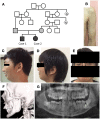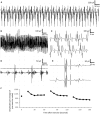A Novel Pathogenic HSPG2 Mutation in Schwartz-Jampel Syndrome
- PMID: 33767660
- PMCID: PMC7985266
- DOI: 10.3389/fneur.2021.632336
A Novel Pathogenic HSPG2 Mutation in Schwartz-Jampel Syndrome
Abstract
Schwartz-Jampel syndrome is a rare autosomal recessive disease caused by mutation in the heparan sulfate proteoglycan 2 (HSPG2) gene. Its cardinal symptoms are skeletal dysplasia and neuromuscular hyperactivity. Herein, we identified a new pathogenic mutation site (NM_005529.6:c.1125C>G; p.Cys375Trp) of HSPG2 leading to Schwartz-Jampel syndrome by whole-exome sequencing. This mutation carried by the asymptomatic parents was previously registered in a single-nucleotide polymorphism database of the National Institutes of Health as a coding sequence variant rs543805444. The pathogenic nature of this missense mutation was demonstrated by in silico pathogenicity assessment, clinical presentations, and cellular function of primary fibroblast derived from patients. Various in silico software applications predicted the mutation to be pathogenic [Sorting Intolerant From Tolerant (SIFT), 0; Polyphen-2, 1; CADD (Combined Annotation Dependent Depletion), 23.7; MutationTaster, 1; DANN (deleterious annotation of genetic variants using neural networks); 0.9]. Needle electromyography revealed extensive complex repetitive discharges and multiple polyphasic motor unit action potentials in axial and limb muscles at rest. Short exercise test for myotonia showed Fournier pattern I. At cellular levels, mutant primary fibroblasts had reduced levels of secreted perlecan and impaired migration ability but normal capability of proliferation. Patients with this mutation showed more neuromuscular instability and relatively mild skeletal abnormality comparing with previously reported cases.
Keywords: Schwartz–Jampel syndrome; heparan sulfate proteoglycan 2; perlecan; primary fibroblast; short exercise test.
Copyright © 2021 Lin, Hung, Hsu, Chang and Sun.
Conflict of interest statement
The authors declare that the research was conducted in the absence of any commercial or financial relationships that could be construed as a potential conflict of interest.
Figures





Similar articles
-
Identification of a novel splice site HSPG2 mutation and prenatal diagnosis in Schwartz Jampel Syndrome type 1 using whole exome sequencing.Neuromuscul Disord. 2016 Nov;26(11):809-814. doi: 10.1016/j.nmd.2016.07.004. Epub 2016 Jul 16. Neuromuscul Disord. 2016. PMID: 27521129
-
Successful Treatment of Schwartz-Jampel Syndrome with Botulinum Toxin Type A.Dermatol Ther (Heidelb). 2024 Feb;14(2):545-556. doi: 10.1007/s13555-023-01088-7. Epub 2024 Jan 28. Dermatol Ther (Heidelb). 2024. PMID: 38285320 Free PMC article.
-
[Clinical and genetic features of Schwartz-Jampel syndrome in a Chinese child: case report and literature review].Zhonghua Er Ke Za Zhi. 2015 Nov;53(11):855-9. Zhonghua Er Ke Za Zhi. 2015. PMID: 26758326 Review. Chinese.
-
Spectrum of HSPG2 (Perlecan) mutations in patients with Schwartz-Jampel syndrome.Hum Mutat. 2006 Nov;27(11):1082-91. doi: 10.1002/humu.20388. Hum Mutat. 2006. PMID: 16927315
-
Modular Proteoglycan Perlecan/HSPG2: Mutations, Phenotypes, and Functions.Genes (Basel). 2018 Nov 16;9(11):556. doi: 10.3390/genes9110556. Genes (Basel). 2018. PMID: 30453502 Free PMC article. Review.
Cited by
-
Case report: Episodic ataxia without ataxia?Front Neurol. 2023 Oct 26;14:1224241. doi: 10.3389/fneur.2023.1224241. eCollection 2023. Front Neurol. 2023. PMID: 37965175 Free PMC article.
-
Expanding genetic and clinical aspects of Schwartz-Jampel syndrome: A report of two cases with literature review.Mol Genet Metab Rep. 2024 Jul 24;40:101125. doi: 10.1016/j.ymgmr.2024.101125. eCollection 2024 Sep. Mol Genet Metab Rep. 2024. PMID: 39157536 Free PMC article.
-
Dyssegmental dysplasia Rolland-Desbuquois type is caused by pathogenic variants in HSPG2 - a founder haplotype shared in five patients.J Hum Genet. 2024 Jun;69(6):235-244. doi: 10.1038/s10038-024-01229-6. Epub 2024 Feb 29. J Hum Genet. 2024. PMID: 38424183 Free PMC article.
-
Perlecan, A Multi-Functional, Cell-Instructive, Matrix-Stabilizing Proteoglycan With Roles in Tissue Development Has Relevance to Connective Tissue Repair and Regeneration.Front Cell Dev Biol. 2022 Apr 1;10:856261. doi: 10.3389/fcell.2022.856261. eCollection 2022. Front Cell Dev Biol. 2022. PMID: 35433700 Free PMC article. Review.
-
Epilepsies of presumed genetic etiology show enrichment of rare variants that occur in the general population.Am J Hum Genet. 2023 Jul 6;110(7):1110-1122. doi: 10.1016/j.ajhg.2023.06.004. Epub 2023 Jun 26. Am J Hum Genet. 2023. PMID: 37369202 Free PMC article.
References
LinkOut - more resources
Full Text Sources
Other Literature Sources

